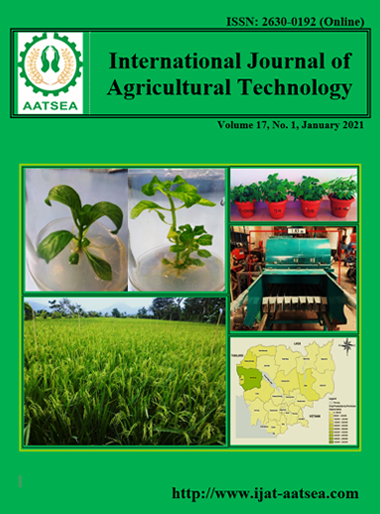Effects of disc peg drum parameters on maize shelling performance of an axial flow shelling unit
Main Article Content
Abstract
Reserch finding showed that an increase in guide vane inclination and rotor speed resulted in increased maize shelling efficiency and decreased total loss, whereas feed rate and moisture content did not statistically affect shelling efficiency or total loss. A higher moisture content resulted in increased grain breakage while rotor speed, feed rate, and guide vane inclination did not statistically affect grain breakage. A higher moisture content, guide vane inclination, feed rate, and rotor speed tended to increase power consumption. Meanwhile, a higher moisture content, guide vane inclination, and rotor speed tended to increase specific energy consumption whereas an increased feed rate tended to reduce it. Optimal parameters of the drum were a moisture content of less than 17 %wb, a feed rate of less than 2 tons/hr, a guide vane inclination of more than 87 degrees, and a rotor speed of more than 12 m/s.
Article Details

This work is licensed under a Creative Commons Attribution-NonCommercial-NoDerivatives 4.0 International License.
References
Al Sharifi, S. K. A., Aljibouri, M. A. and Taher, M. A. (2019). Effect of threshing machines, rotational speed and grain moisture on corn shelling. Bulgarian Journal of Agricultural Science, 25:243-255.
Bakoye, O. N., Baoua, I. B., Seyni H., Amadou L., Murdock, L. L. and Baributsa, D. (2017). Quality of maize for sale in markets in Benin and Niger. Journal of Stored Products Research, 71:99-105.
Burger, H. M., Shephard, G. S., Louw, W., Rheeder, J. P. and Gelderblom, W. C. A. (2013). The mycotoxin distribution in maize milling fractions under experimental conditions. International Journal of Food Microbiology, 165:57-64.
Berger, P. D. and Maurer, R. E. (2002). Experimental Design with Applications in Management, Engineering, and the Sciences. U.S.A., pp.413-416.
Chuan-Udom, S., Thongsawatwong, P., Saengprachatanarug, K. and Taira, E. (2018). Peg-tooth spacing and guide vane inclination of a Thai combine harvester affecting harvesting losses. Engineering and Applied Science Research, 45:107-111.
Chuan-Udom, S. (2013). Operating factors of Thai threshers affecting corn shelling losses. Songklanakarin Journal of Science and Technology, 35:63-67.
El-Desukey, N., Mousa, E. and Lotfy, A. (2007). Feasibility of using corn sheller machine in threshing sunflower. Journal of Agriculture and Environmental Sciences. Alexandria University Egyptian, 6:17-33.
Farjam, A., Omid, M., Akram, A. and Fazell Niari, Z. (2014). A Neural Network Based Modeling and Sensitivity Analysis of Energy Inputs for Predicting Seed and Grain Corn Yields. Journal of Agricultural Science and Technology, 16:767-778.
Fox, G. P. and O’Hare, T. J. (2017). Analysing maize grain quality, Achieving sustainable cultivation of maize Volume 1. Burleigh Dodds Science Publishing, United Kingdom, pp.237-260.
Giorni, P., Battilani, P., Pietri, A. and Magan, N. (2008). Effect of aw and CO2 level on Aspergillus flavus growth and aflatoxin production in high moisture maize postharvest. International Journal of Food Microbiology, 122:109-113.
Haros, M., Tolaba, M. P. and Suarez, C. (2003). Influence of corn drying on its quality for the wet-milling process. Journal of Food Engineering, 60:177-184.
Miu, P. I. and Kutzbach, H. D. (2008a). Modeling and simulation of grain threshing and separation in threshing units—Part I. Computers and electronics in agriculture, 60 :96-104.
Miu, P. I. and Kutzbach, H. D. (2008b). Modeling and simulation of grain threshing and separation in axial threshing units Part II. Application to tangential feeding. Computers and electronics in agriculture, 60:105-109.
Naqvi, S., Ramessar, K., Farre, G., Sabalza, M., Miralpeix, B., Twyman, R. M., Capell, T., Zhu, C. and Christou, P. (2011). High-value products from transgenic maize. Biotechnology Advances, 29:40-53.
Oladejo, J. A., Ajetomobi, J. O. and Fabiyi, Y. L. (2011). Transactions Costs and Agricultural Household Supply Response of Maize Farmers in Oyo State of Nigeria. Journal of agriculture and social sciences, 7:69-74.
Ranum, P., Pena-Rosas, J. P. and Garcia-Casal, M. N. (2014). Global maize production, utilization, and consumption. Annals of the New York Academy of Sciences, 1312:105-112.
RNAM (1995). Test Codes & Procedures for Farm Machinery, Technical Series No.12, Second edition, Economic and Social Commission for Asia and the Pacific. Bangkok, Thailand, pp.468.
Saeng-ong, P., Chuan-Udom, S. and Saengprachatanarug, K. (2015). Effects of Guide Vane Inclination in Axial Shelling Unit on Corn Shelling Performance. Kasetsart Journal (Natural Science), 49:761-771.
Srison, W., Chuan-Udom, S. and Saengprachatanarug, K. (2016a). Design factors affecting losses and power consumption of an axial flow corn shelling unit. Songklanakarin Journal of Science and Technology, 38:591-598.
Srison, W., Chuan-Udom, S. and Saengprachatanarug, K. (2016b). Effects of operation factors for an axial-flow corn shelling unit on losses and power consumption. Agriculture and Natural Resources, 50:421-425.
Steponavičius, D., Pužauskas, E., Špokas, L., Jotautienė, E., Kemzūraitė, A. and Petkevičius, S. (2018). Concave Design for High-Moisture Corn Ear Threshing. Mechainka, 24:80-91.
Suleiman, R., Bern, C. J., Brumm, T. J. and Rosentrater, K. A. (2018). Impact of moisture content and maize weevils on maize quality during hermetic and non-hermetic storage. Journal of Stored Products Research, 78:1-10.
Ukatu, A. C. (2006). A Modified Threshing Unit for Soya Beans. Biosystems Engineering, 95:371-377.
Wallington, T. J., Anderson, J. E., Mueller, S. A., Kolinski Morris, E., Winkler, S. L., Ginder, J. M. and Nielsen, O. J. (2012). Corn Ethanol Production, Food Exports, and Indirect Land Use Change. Environmental Science & Technology, 46:6379-6384.
Wacker, P. (2005). Maize Grain Damage during Harvest. Landtechnik, 60:84-85.
Yu, Y., Fu, H. and Yu, J. (2015). DEM-based simulation of the corn threshing process. Advanced Powder Technology, 26:1400-1409.


